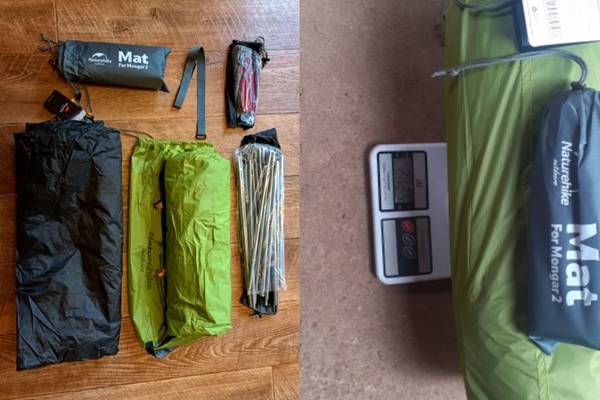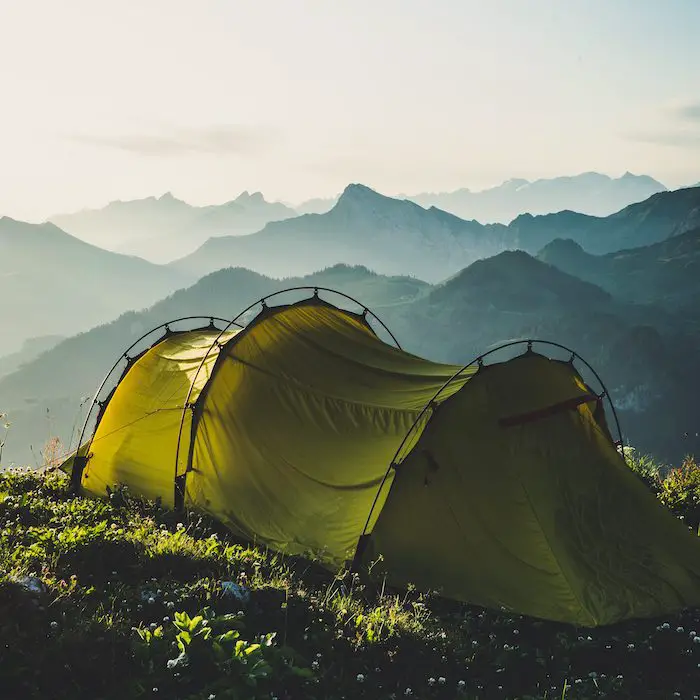Are you looking to take your next camping trip off the beaten path? Do you want to explore the great outdoors, but don’t know what gear is right for you? If so, you’re in luck!
Not all tents come with stakes. It depends on the specific tent model and brand. Some tents may come with stakes included, while others may not.
When purchasing a tent, it’s important to carefully read the product description or packaging to see what accessories are included. If stakes are not included, they will need to be purchased separately.
It’s also worth noting that the stakes that come with a tent may not always be the best quality or suitable for all camping conditions. It may be worthwhile to invest in higher quality stakes that are appropriate for the terrain and weather conditions you will be camping in.
In this article, we’ll discuss everything there is to know about tent stakes and how they can help make outdoor adventures more enjoyable. We’ll look at different types of tent stakes, their benefits and other information that will make sure you have a safe and comfortable experience no matter where your trekking takes you.
So get ready for an adventure – let’s dive into all things related to tent stakes!
Overview Of Tent Setups
When setting up tents, selecting the right tent for your needs is paramount. Weight and size should be taken into consideration as you will need to carry it with you on your journey.
Make sure that whatever materials make up the tent are waterproofed and windproof so there is no chance of leaks or being blown away in strong winds.

Tent anchors can play a huge role in how secure your tent setup is. Anchors vary based on terrain type, which makes choosing the correct anchor an essential part of the selection process when camping out in nature.
Moving on, let’s take a look at some popular types of tent anchors…
Types Of Tent Stakes and Anchors
When it comes to setting up a tent, the anchors you choose are just as important as the tent itself. Whereas stakes and pegs drive into the ground, weights and anchors provide stability from above. Before deciding which is best for your setup, there are several factors to consider:
1. The type of surface or ground condition where you plan on camping;
2. The material used in constructing the tent;
3. Securing techniques available such as staking, sandbagging etc.
Ideally, if the ground conditions are hard enough, stakes will be more effective than other anchoring methods since they’re designed to penetrate deep into soil and secure your shelter with minimal effort. But even then, it pays off to bring along additional weights like rocks or bags full of sand that can act as extra anchors when needed—especially if you’re expecting high winds.
Of course this all depends on what kind of materials were used in making your tent; some fabrics offer better protection against windy weather than others! The most important thing is to make sure whatever method you use provides a strong connection between your shelter and Mother Nature.
No matter what technique you decide upon for securing your campsite, it’s always wise to have an alternative plan ready before hitting the trail – especially during extreme weather changes! Knowing how to adjust accordingly can mean the difference between a safe night under cover and getting caught out in a storm without proper protection.
With these tips in mind, campers should feel confident about choosing their preferred anchoring system – whether it be stakes vs pegs or anchors vs weights – so they can get back outside and explore with peace of mind! Ready for the next step? Let’s take a look at the benefits of using tent stakes!
Do You Need Tent Stakes – What are The Benefits?
Stakes provide stability for your tent by anchoring it to the ground. They also ensure security by keeping your tent from blowing away in strong winds. Finally, stakes offer protection from the elements, such as rain and snow, by keeping the tent walls taut.

Stability
Are you curious about the benefits of tent stakes? Well, let me tell you – stability is key!
When setting up your tent, using stakes to secure its corners and guylines will help ensure that it stays in place no matter what. A good setup guide will show you exactly how many stakes are needed for different kinds of weather conditions and terrain.
Additionally, if you’re camping in an area where the ground isn’t quite level or has lots of rocks, a tent footprint can be handy too – providing extra protection from punctures while also helping keep the wind out.
Finally, don’t forget to pack plenty of spare cordage to secure those stakes properly … because when it comes to tents, nothing beats a secure foundation!
Security
When it comes to camping, security is an essential part of the equation. So, having a good groundsheet can be really helpful too – providing extra protection from punctures and helping keep any moisture away from your tent.
Similarly, using tent pegs that are weatherproofed will ensure they don’t rust or break in the wind. Plus, you won’t have to worry about them coming loose in bad conditions either!
With these pieces all working together, you’ll never feel more secure while out on the trails. Here’s to enjoying all that nature has to offer without sacrificing your safety; happy adventuring!
Protection
It’s no secret that tent stakes are essential when it comes to camping – they help anchor your shelter and provide a secure base for you, so you can enjoy the great outdoors without worrying about any potential disasters.
There are different anchoring techniques depending on the type of tent materials, ground conditions and weather, but all will be beneficial in keeping your home away from home safe.
Whether you’re dealing with rocky terrain or soft soil, strong winds or gentle breezes, there is an effective solution to ensure your tent stays put!
With proper protection from these tent stakes, nothing can stand between you and the freedom that nature has to offer.
How To Choose Tent Stakes
When it comes to outfitting your tent with stakes, the choices can seem endless. But don’t let that overwhelm you! With some simple guidelines and a few considerations, you’ll be able to choose the right stakes for your camping needs in no time.
First off, consider sizing guidelines; while there is some variation based on terrain and soil type, generally speaking 9-inch stakes are best suited for most soft soils. If you’re planning on pitching your tent on harder ground or snow, opt for longer options like 11-inch stakes instead.
Weight is also an important consideration; if you plan on carrying your gear over long distances, look for lightweight aluminum or titanium options that won’t weigh down your backpack too much. There’s also plastic and steel variations available as well depending on the function needed for each specific stake.
Once you’ve chosen a material option that fits your requirements, it’s time to think about installation techniques. Before hammering any stakes into place make sure to prepare the ground accordingly – remove rocks and other debris from where the stake will go so it doesn’t snag when inserting it into the earth below.
Then use a mallet (or rock) to drive them in firmly but not all the way through; they should only penetrate halfway into the ground surface at maximum.
And finally check every once in awhile throughout your stay to ensure everything remains firmly planted in place – especially after heavy rains which may loosen up already established tentsites.
No matter what kind of stake you select, one thing is certain: following these sizing guidelines, weight considerations, material options and proper installation techniques will help guarantee a safe and sound shelter wherever your next adventure takes you!
Frequently Asked Questions
What Are The Best Tents For Camping?
When it comes to selecting the best tents for camping, there are a variety of factors that must be taken into consideration.
From sizing tents and tent materials to tent construction, weatherproofing and even extra camping gear, finding the right fit is essential in order to ensure an enjoyable outdoor experience.
For those looking to make the most out of their next adventure, understanding how each factor plays into purchasing a tent can help make all the difference.
How Much Do Tent Stakes Cost?
When it comes to setting up tents, it’s essential to have the right tent stakes. Whether you’re a weekend warrior or an avid camper, the materials and styles of your tent stakes can make or break your camping experience.
Tent stakes come in all shapes, sizes, and materials – from lightweight aluminum to durable steel – so no matter what kind of camping gear you’re using, there is something perfect for any type of tent style.
With prices ranging from just a few dollars per stake to more expensive models designed for larger tents and heavier materials, finding the ideal choice for your setup won’t break the bank. So don’t get caught out in the wild without the proper equipment; invest in quality tent stakes that will last through all kinds of weather conditions!
Are Tent Stakes Necessary?
As an outdoor expert, I can confidently tell you that the answer is yes. Depending on the type of stake and tent material used, tent stakes help keep your shelter in place during windy weather and ensure it stays upright when weighed down by heavy snowfall or rain.
Different types of stakes should be paired with different tents to provide a secure fit; for instance, aluminum stakes are lightweight yet durable enough to hold steady against heavier tents made from canvas or polyester.
Installation also varies depending on stake materials; plastic stakes may require hammering into hard ground while pegs only need to be pushed into softer soil. To make sure your camping experience goes as smoothly as possible, remember: never underestimate the importance of properly securing your tent!
How Do You Install Tent Stakes?
Setting up a tent can be tricky, but with the right tools and techniques you can have it securely anchored in no time. Ground preparation is key to ensure your tent stays firmly in place, not even the strongest winds will be able to blow it away!
From materials comparison to windproofing techniques, there are several tips that an outdoor expert would recommend when installing stakes into the ground. Anchoring methods also play an important role when pitching tents so make sure you understand all the steps involved before starting – from setting up tips to properly securing each stake for maximum stability.
With just a little bit of knowledge, you’ll be ready to enjoy your camping experience in no time!
Are There Alternatives To Tent Stakes?
When it comes to pitching a tent, stakes are an essential part of the setup. But there are plenty of alternatives that can help you get your tent up in no time and offer added wind resistance for a secure fit.
From metal hooks to specialized fabric pockets, these alternative materials can be used with most types of tent fabrics and staking materials.
With just a few simple pitching tips, you’ll have your tent set up quickly so you can enjoy the great outdoors without sacrificing security or comfort!
Conclusion
When it comes to camping, there’s nothing like a good tent. Tents come in all shapes and sizes so you can find something that fits your needs.
Most tents will include tent stakes, but if they don’t – don’t worry! Tent stakes are relatively inexpensive and easy to install. Even if you’re not an expert camper, setting up a few tent stakes isn’t hard at all.
Another great option for securing your tent is using rocks or logs around the perimeter of the tent instead of traditional metal stakes. This method has been used by generations of campers, and it’s just as effective as staking out a tent with metal anchors.
Not only does this add a little extra protection against strong winds or rainstorms, but these natural elements also provide some symbolic balance between manmade structures (the tent) and nature itself.
In conclusion, while it depends on the type of tent you have, most tents do come with their own set of stakes. If they don’t though, metal ones typically aren’t too expensive and they are easy enough to install even for novice campers.
And those who want to get creative can use rocks or logs instead – which may be more aesthetically pleasing anyway!
In any case, make sure your shelter is properly secured before settling down for the night so you can enjoy peaceful rest under the stars!




